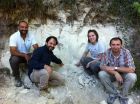Photopharmacology: Optical control of insulin secretion
2014-10-14
(Press-News.org) Researchers at Ludwig-Maximilians-Universitaet (LMU) in Munich have chemically modified an anti-diabetic agent so as to make its action dependent on light. The resulting prototype compound, termed JB253, induces release of insulin only when pancreas cells are exposed to blue light.
Synthetic, light-sensitive, molecular switches can be utilized to control biochemical signaling processes in living cells. In a new study, a research team led by LMU Professor Dirk Trauner (Chemical Biology and Genetics) and his colleague Johannes Broichhagen, in collaboration with Prof. Guy Rutter and Dr. David Hodson at Imperial College London, have succeeded in incorporating such an optical switch into a sulfonylurea compound; a class of drugs which is widely used to regulate blood glucose levels in patients with Type 2 diabetes. Details of the new work appear in the journal "Nature Communications".
Dirk Trauner explains the basic principle behind the experimental approach as follows: "We utilize synthetic molecular switches whose structure is altered by light in conjunction with the natural receptor proteins for specific signaling molecules. The chemical switches effectively make the receptor's function dependent on exposure to light of a certain color. Light can be controlled with exquisite precision, which allows us to target the receptor of interest with very high specificity. In addition, the activating reaction is itself reversible."
Indeed, it should be possible to control the action of any drug by means of light, opening up novel therapeutic strategies for the treatment of chronic illnesses such as diabetes. Diabetes results from loss of the ability to produce or the capacity to react to insulin, which controls the uptake, metabolism and storage of glucose by cells. The hormone is secreted by the beta-cells of the pancreas when levels of glucose in the bloodstream rise, and thus serves to keep the concentration of the sugar in the circulation within narrow limits. In Type 2 diabetes, the amounts of insulin released are insufficient to compensate for reduced responsiveness to the hormone. Synthetic drugs called sulfonylureas, which promote secretion of insulin, are therefore used to treat the disease. Trauner and his colleagues have now synthesized a light-sensitive sulfonylurea, called JB253, and tested its ability to stimulate insulin release in laboratory experiments. They were able to show that pancreatic cells incubated with the compound secreted insulin only when exposed to blue light, which converts JB253 into a form that is recognized by its target protein, a potassium channel. Once the light is turned off, JB253 reverts to the inactive form and the effect on the potassium channel and downstream signaling pathways ceases.
"Take one a day, with lots of light"
The potassium channels targeted by sulfonylureas on the beta-cell surface are open when extracellular glucose levels are low. Rising levels induce uptake and metabolism of glucose, which causes the pores to close, activating insulin release, and sulfonylureas mimic this effect. "Our JB253 prototype could give us an important tool with which to dissect the function of the potassium channels," says Trauner. But he also believes that photopharmacology can do more than provide novel insights for basic researchers: "We are convinced that it will also become clinically relevant in the not too distant future."
The idea is that light-sensitive drugs could be administered in the form of a pill, and then be released or activated by irradiating a patch of skin with a blue LED. When the light is switched off the drug flips back into the inactive form. "We have a long way to go before it will be possible to use such a therapy in patients. It would, however, give better control over blood sugar levels during type 2 diabetes, and would reduce the incidence of side-effects, because the active agent is released only where it is required," says Dr. Hodson of Imperial College London. The next challenge will be to verify that the new compound JB253 is in fact capable of lowering blood sugar levels in animal models of Type 2 diabetes.
INFORMATION:
ELSE PRESS RELEASES FROM THIS DATE:
2014-10-14
Imagine the world waking up one morning to discover that all compasses pointed south instead of north.
It's not as bizarre as it sounds. Earth's magnetic field has flipped – though not overnight – many times throughout the planet's history. Its dipole magnetic field, like that of a bar magnet, remains about the same intensity for thousands to millions of years, but for incompletely known reasons it occasionally weakens and, presumably over a few thousand years, reverses direction.
Now, a new study by a team of scientists from Italy, France, Columbia University ...
2014-10-14
ITHACA, N.Y. – Scientists have sequenced the house fly genome for the first time, revealing robust immune genes, as one might expect from an insect that thrives in pathogen-rich dung piles and garbage heaps.
The research, published Oct. 14 in the journal Genome Biology, will increase understanding of house fly genetics and biology and of how flies quickly adapt to resist insecticides, which could lead to novel control methods.
Adult house flies (Musca domestica) carry and transmit more than 100 human and animal diseases, including salmonellosis, anthrax, typhoid ...
2014-10-14
NASA's Aqua satellite passed over Tropical Storm Ana on Monday, Oct. 13 after it formed in the Central Pacific Ocean.
Ana formed on Oct. 13 at 5 p.m. EDT (11 a.m. HST) as Tropical Depression 2-C, about 920 miles (1,480 km) east-southeast of Hilo, Hawaii. By 9 p.m. EDT that day, the depression had strengthened into Tropical Depression Ana.
NASA's Aqua satellite passed over Tropical Storm Ana on Monday, Oct. 13 at 11:11 UTC (7:11 a.m. EDT) and the Atmospheric Infrared Sounder or AIRS instrument gathered infrared data that showed some strong thunderstorms and cold cloud ...
2014-10-14
WASHINGTON, DC— The 1934 drought was by far the most intense and far-reaching drought of the last 1,000 years in North America, and was caused in part by an atmospheric phenomenon that may have also led to the current drought in California, according to a new study.
New research finds that the extent of the 1934 drought was approximately seven times larger than droughts of comparable intensity that struck North America between 1000 A.D. and 2005, and nearly 30 percent worse than the next most severe drought that struck the continent in 1580.
"We noticed that ...
2014-10-14
One of the planet's leading questions is how to produce enough food to feed the world in an increasingly variable climate. The Food and Agriculture Organization of the United Nations predicts that food production must rise 70% over the next 40 years to feed a growing global population, and plants are one major component of the necessary rise in food production. Plants—grains, cereals, fruits, vegetables, and more—feed humans directly and indirectly by supporting livestock. Current research must tap into our knowledge of how plants work to develop more efficient ...
2014-10-14
From AGU's blogs: Health check reveals how glacier is declining due to warming climate http://blogs.agu.org/geospace/2014/10/13/health-check-reveals-glacier-declining-due-warming-climate/
Researchers from the British Geological Survey have taken the very first comprehensive health check of a rapidly melting glacier. Their latest study reveals that their icy patient, the Falljökull glacier in southeast Iceland, has been dramatically declining as it tries to adjust to recent changes in the climate.
The new findings on Falljökull show unhealthy changes in the ...
2014-10-14
URBANA, Ill. – For about a decade, Chinese consumers weren't getting what they paid for when they purchased Wuchang, a special brand of gourmet rice that has a peculiar scent. The quality was being diluted when less expensive rice was aromatized, added to the packages of the high-quality rice, and sold at the premium price. Researchers at the University of Illinois studied how the tampering scandal affected the public's perception of risk and their subsequent behavior.
Because public anxiety over the fake rice issue was more pronounced in urban districts, the researchers ...
2014-10-14
A Mount Sinai-led research team has discovered a new kind of stem cell that can become either a liver cell or a cell that lines liver blood vessels, according to a study published today in the journal Stem Cell Reports. The existence of such a cell type contradicts current theory on how organs arise from cell layers in the embryo, and may hold clues to origins of, and future treatment for, liver cancer.
Thanks to stem cells, humans develop from a single cell into a complex being made up of more than 200 cell types. The original, single human stem cell, the fertilized embryo, ...
2014-10-14
Montreal, October 14, 2014 – High doses of fish oil supplements, rich in omega-3 fatty acids, do not reduce atrial fibrillation, a common type of irregular heartbeat in which the heart can beat as fast as 150 beats a minute. The results of the AFFORD trial led by the Montreal Heart Institute were published in the Journal of the American College of Cardiology on October 7th.
For the trial, 337 patients with atrial fibrillation not receiving conventional antiarrhythmic therapy were randomly assigned to 4 grams of fish oil a day or to placebo for up to 16 months. 64.1 ...
2014-10-14
Can you ditch the strips and dump the dentist for whiter teeth? From "The Dr. Oz Show" to YouTube videos, experts say you can reclaim those pearly whites simply by mixing fruit, such as strawberries, with some baking soda, and applying the all-natural concoction to your teeth.
It's cheap, easy, and oh-so-organic. But does it work?
Unfortunately not, says an University of Iowa dental researcher, who compared a homemade strawberry-baking soda recipe with other remedies, such as over-the-counter products, professional whitening, and prescribed whitening products.
The ...
LAST 30 PRESS RELEASES:
[Press-News.org] Photopharmacology: Optical control of insulin secretion



